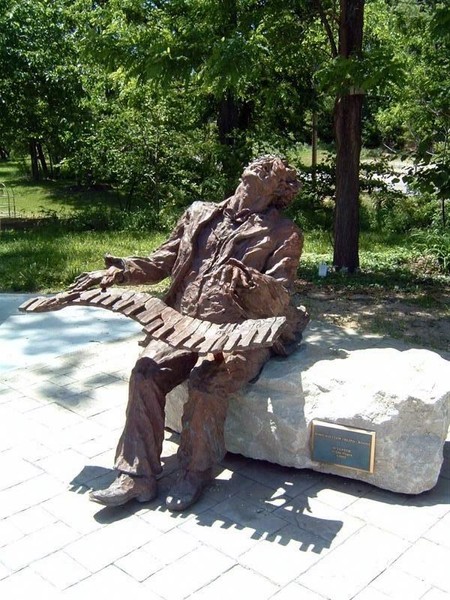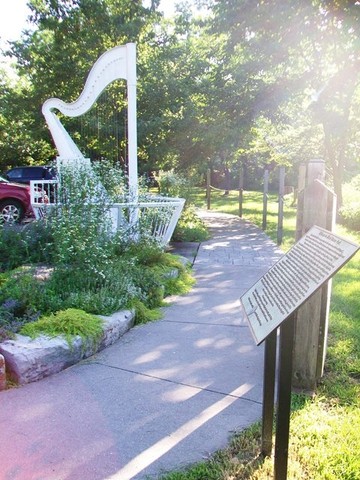Blind Boone Park and Statue of John William "Blind" Boone
Introduction
Text-to-speech Audio
Born in a Union military camp during the Civil War to a formerly enslaved soldier, John William “Blind” Boone overcame poverty, disability, and racism to become a nationally acclaimed composer and musician. Blind since his infancy, Boone trained himself to be a musician and demonstrated unique skills in performing everything from classical music to African spirituals. He also became a pioneer of ragtime music. The park that honors him was created in 1954 in the era of segregation and originally served the African American community of Warrensburg. A substantial renovation project from 2000 to 2005 involving 3,000 volunteers resulted in a landmark ADA-accessible 3.28-acre park that honors Boone's life and legacy. The park features a statue of Blind Boone, braille signs, a scent garden, wind harp, gazebo, and reflexology path.
Images
John William "Blind" Boone

Sculpture of John William "Blind" Boone at Blind Boone Park

13' Wind Harp designed by artist Ron Konzak & played by a 15 mph wind that produces sound by vibrating the tuned metal harp strings. Located at Blind Boone Park

Backstory and Context
Text-to-speech Audio
Blind Boone Park was created in the era of segregation but has long been open to all while continuing to honor the Black community with interpretive signs and a statue that honors the memory of John William "Blind" Boone. Despite being blind, impoverished, and faced with racism, Boone became a famous concert pianist and a pioneer of ragtime music.
Boone was born in a Federal militia camp during the Civil War (1864) near Miami, Missouri. His mother, Rachel Boone, was considered a "contraband slave" because her previous owner supported Confederate forces. His father, William S. Belcher, served with the Union Army and was a bugler in the 7th Missouri State Militia Cavalry. Boone fell ill at six months with cerebral meningitis, known then as "brain fever." Doctors at the time felt it necessary to relieve the brain swelling, so they performed a radical surgical procedure that involved removing Boone's eyes and sewing the lids shut. Today, doctors treat this same illness with antibiotics.
Boone spent his childhood in Warrensburg near the headquarters of Camp Grover, where his father's unit was stationed. The community raised money to help send Boone to the Missouri School for the Blind in St. Louis. The school taught braille, music, and broom-making skills. While there, he met Enoch Donnelly, an older white student, who appreciated Boone's strong music interest. After he heard Boone playing one of his classical music pieces on the piano, Donnelly sacrificed some of his practice time to tutor Boone. Boone had a knack for skillfully playing songs correctly after hearing them. Before long, Boone earned money during school breaks by playing piano for church services and social gatherings in Warrensburg.
When Boone returned to school, a new superintendent ran the Missouri School for the Blind who did not believe Black students deserved the same opportunities as other students. As a result, the new superintendent forbade Black students from playing the piano. Boone reacted by skipping classes to visit the saloons in the nearby "Tenderloin District," where he listened to and played music with the African American musicians; the principal expelled Boone because of his absences. Boone was afraid to return home and give his mom the bad news, so he attempted to stay in St. Louis and earn money playing music. Eventually, he ran out of money, so he returned home with the help and kindness of a white railroad conductor named A. J. Kerry.
In addition to the many challenges in his life, Boone was taken advantage of by a local gambler. Mark Cromwell heard Boone play his harmonica, so Cromwell conned Boone's mother and convinced Boone that he could book Blind John on a series of concert engagements. Alas, Cromwell kept all the money for himself and, at one point, reportedly "lost" Boone in a poker game. Cromwell managed to "steal" the young musician back three days later. Fortunately, Boone's step-father, Harrison Hendricks who married Rachel Boone married in 1871 found Boone and returned him safely to Warrensburg.
In 1879, a contractor from Columbia, Missouri, John B. Lange, Jr., heard Boone play and subsequently approached Boone about going on tour; he gave Boone the nickname Blind John. At first, Boone drew small crowds and earned little money, but Boone spent two months in Iowa at the home of George Sampson, an accomplished pianist who taught Boone how to play the European classics properly. And impressed Lange returned to the road with Boone and a new vocalist, which he billed as the Blind Boone Concert Company. The improved Boone and his vocalist gained a large following and earned a healthy wage. They returned to Columbia in 1887 with a large sum of money and, two years later, Boone married John Lange's sister, Eugenia Lange.
By the turn of the century, Boone's show stood among the most popular acts in the country, playing more than 300 concerts annually. He earned a substantial amount of money, enough to buy a house for him and his wife, as well as several pianos. Though Boone played several instruments, the piano remained his favorite; he practiced upwards of six hours a day. John Lange died in Kansas City in 1916, but Boone continued to travel and play, including spending an entire month in New York City in 1919. Upon announcing his retirement from touring in 1924. Unfortunately, after Lange died, Boone worked with an unethical manager, leaving Boone financially strained, which forced him to play small concerts to make ends meet until his death in 1927.
Boone played in more than 7,000 concerts over his lifetime in the U.S. and Canada. His music involved several influences, notably traditional African American music, classical music, and ragtime -- a style that grew exceptionally popular after World War I. Indeed, historians of jazz and ragtime often mention Boone's influence in the evolution of American music.
Meanwhile, the park that honors Boone emerged in 1954 as a segregated park with only restrooms & two BBQ grills. While Boone enjoys fame for his musical talent, his life also served as a window into the history of racism and discrimination. His mom, a former slave, took care of him. Meanwhile, a superintendent at the Missouri School for the Blind forbade him from playing music. The new 3.28-acre park, constructed between 2000 - 2005 by more than 3,000 volunteers, honors Boone's work and celebrates inclusivity, including different races and those dealing with physical challenges. The ADA-accessible park features a statue of Blind Boone, braille signs, a scent garden, wind harp, gazebo, and reflexology path.
Sources
"'Blind' Boone." Historic Missourians (blog). Accessed November 2, 2021. https://historicmissourians.shsmo.org/blind-boone.
Blind Boone Home. Accessed November 2, 2021. https://blindboonehome.org/.
Fischer, William. "Welcome to Blind Boone Park." The Historical Marker Database. HMdb.org. June 16, 2016. https://www.hmdb.org/m.asp?m=85378.
Swindell, Warren C. "John William 'Blind' Boone's Chicago Itinerary." Black Music Research Journal 12, no. 1 (1992): 113–25.
"Warrensburg History." Warrensburg Missouri (website). warrensburg-mo.com. Accessed November 2, 2021. https://www.warrensburg-mo.com/590/Warrensburg-History.
By Unknown photographer - The State Historical Society of Missouri, Photograph Collection (P163-09), Public Domain, https://commons.wikimedia.org/w/index.php?curid=76062311
https://www.waymarking.com/waymarks/wm1JE6_Blind_Boone_Warrensburg_Missouri
By William Fischer, Jr., June 20, 2015 @ https://www.hmdb.org/m.asp?m=85378
